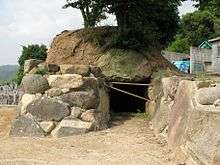Takayasu Senzuka Kofun
| Wikimedia Commons has media related to Takayasu Kofun Group. |
The Takayasu Senzuka Kofun or Takayasukofungun is an ancient tomb group at the foot of Mt. Takayasu which is the east part of Yao, Osaka.[1] The site is designed as a national historic site under the name “Takayasusenzukakofungun”.
History
In the central Takayasu ward of Yao city (Chizuka, Yamatake, Okubo, Hattorigawa) about 200 ancient tombs exist. These areas were called “Senzuka”. It is thought that these ancient tombs were constructed from the 6th to 7th century. Some 600 ancient tombs had been discovered by the survey of Taisho period (1912-1926). Many of the ancient tombs are small round burial mounds, 10 – 20 meters in diameter. They are distributed mostly on Mt. Takayasu hillside with a height of 50-300 meters. Most of the ancient tombs are openoin their south side.
In these areas, only a few people, those with great political power, constructed circular-shaped ancient tombs with rectangular frontage (=a key hole-shaped tumulus). Their authority became divided during the late Kofun period as small local clans came to expand their power. It is thought that such situation made many ancient tombs to concentrate in this area. The details of the tombs are unknown.
In the early Meiji period, Edward Sylvester Morse surveyed and sketched Kaizanzuka-kofun and introduced it as “Dolmen ancient tomb of Japan”. In later research William Gowland tried to take pictures of Nishitsuzuka-kofun (= Double chamber ancient tomb) and published a thesis as “Dolmen of double chamber”. Tsuboi Shougoro published a thesis, “Same origin theory of ancient tombs / graves and dolmens” in 1888.
Okubo / Yakatake sub-group
Kawachi-dolmen (formal name : Ookubo/Yamatake No.36 kofun) is called "Dolmen" or "Dolmen kofun" locally. Its mound was lost, exposing the stone chamber portion. At the end of 2016 bushes surround it.
Shuntokumarukagamizuka (formal name : Ookubo/Yamatake No.27 kofun) is located at the south of the graveyard of Raiko-ji in Yao city. As the stone chamber is collapsed, only the passage part remains, forming a tunnel-shape.
Hattorigawa sub-group

Nishitsuzuka-kofun (formal : Hattorigawa No.25 kofun, popular name : Double chamber dolmen): The mound is collapsed, exposing a part of the stone chamber. Two burial chambers are vertically connected and Nishitsuzuka's name is derived from them. The stone chamber is fragile.
Kourigawa sub-group
Kourigawahigashizuka and Nishituka ancient tombs are widely different from the position to the west.
Kaizanzuka-kofun (formal name : kourigawa No.1 kofun It exists in the ground of Houzo-ji temple): The inner space of the stone chamber is about 15,7m2. It is the largest in the Takayasu-kofun group.
Kourigawahigashizuka-kofun is located about 50m west from Kourigawa crossroad of Japan National Route 170. It is thought that it was constructed at the end of the fifth century. It is a circular‐shaped tomb with rectangular frontage. The northern end has a mound about 50m in diameter. Many buried objects were excavated from the stone chamber at the time of farmland cultivation in 1897.Although an excavational investigation was conducted as an emergency survey for residential development in 2001, the land of Kourigawahigashi-kofun was divided into residential area and it is defunct.
Kourigawanishizuka-kofun is located at the west side about 100m from kourigawahigashi-kofun and it is opposite side of Kourigawa, across the intersection. It is a circular‐shaped ancient tomb with rectangular northern frontage and has a mound about 60m in diameter. Many buried objects were excavated from the stone chamber at the time of farmland cultivation in 1902. The surroundings are mixed forest surrounded by irrigated rice field and garden fields.
References
- ↑ Victor Harris; Kazuo Gotō; British Museum (2003). William Gowland: the father of Japanese archaeology. British Museum. p. 198.